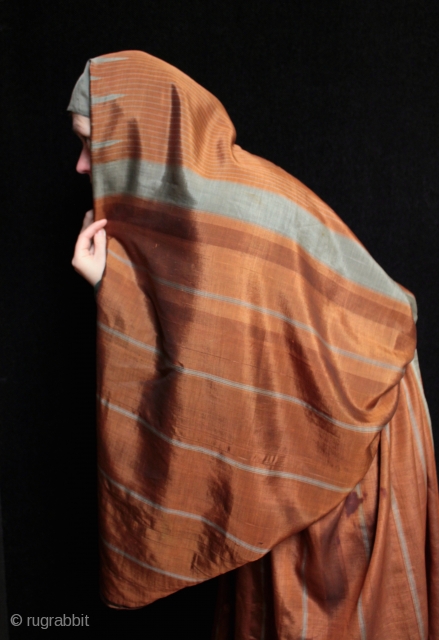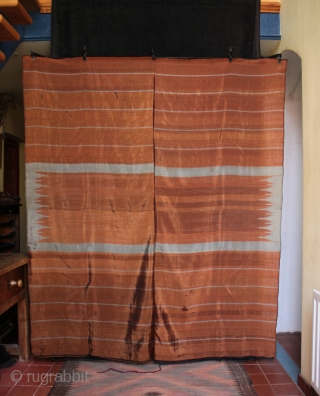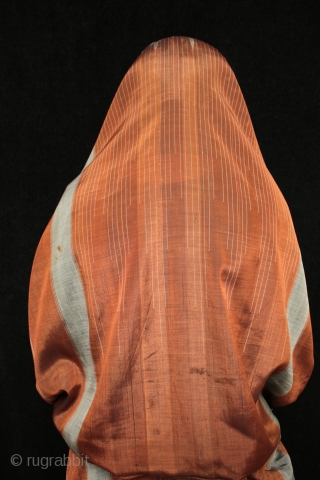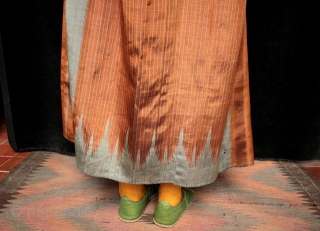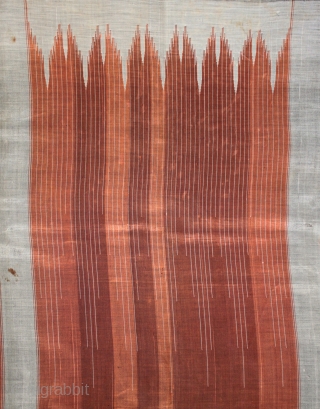Technically a combined skirt and attached shawl, this type of fine woven silk is called 'meydaniyyeh' in local Aleppo/Gaziantep terminology. Often referred to as an 'abba' street dress, the term closer to the original Arabic is abaya. 'The Modern Traveler' of 1825 states that 'abba... is the name reserved for the striped robe'. The abaya is made from two hand woven and hand stitched panels of very unusual light chestnut and golden brown silk of different hues with saf design and stripes in silver grey thread. The two silk panels, which originally formed a double tube, have been unstitched at the ends revealing the original deep blue selvage edge, thus the panels can now be laid flat as seen in the photos and retain one of the two original maroon silk velvet drawstrings.
The abaya robe was most likely woven as a street dress, as in the photos of Kathi modelling it, but they are also sometimes referred to as being used after a hammam Turkish bath. Estimated to be from the late 1900s to early 1900s, the silk was hand woven in Aleppo, Syria near the border with Turkey and Gaziantep.
The abaya is in very good complete condition with some marks from use around the silver grey part of the shawl worn over the head and some small stains in the striped bands (see the last detailed photos from link below). Together they form two double rectangles of strongly woven silk 200cm long and 186cm wide.
Fore more photos see: http://www.kilim.ie/TRIBAL_ART_AND_ANTIQUES/Pages/Aleppo_silk_abaya_dres...
Please contact me for more information.
- Home
- Antique Rugs by Region
- Category
- Profiles
- Post Items Free
- Albums
- Benaki Museum of Islamic Art
- Budapest: Ottoman Carpets
- Gulbenkian Museum
- Islamic Carpets. Brooklyn
- Islamic Textiles. Brooklyn
- Konya Museum: Rugs
- MKG, Hamburg
- MMA: Caucasian Carpets
- MMA: Mamluk Carpets
- MMA: Mughal Indian Carpets
- MMA: Ottoman Carpets
- MMA: Safavid Persian Carpets
- MMA: Turkmen Rugs
- McCoy Jones Kilims
- Ottoman textiles. Met
- Philadelphia Museum
- Rugs and Carpets: Berlin
- Seljuqs at the Met
- TIEM, Istanbul: Carpets
- V&A: Classical Carpets
- Vakiflar Carpets: Istanbul
- Baluch Rugs: Indianapolis
- Gallery Exhibitions
- Jaf an Exhibition
- Alberto Levi Gallery
- Andean Textile
- Christie's London: 2016
- Francesca Galloway
- HALI at 40
- ICOC Washington, DC 2018
- Jajims of the Shahsavan
- London Islamic Week April, 2018
- Mongolian Felts
- Navajo Rugs: JB Moore
- Persian Piled Weavings
- SF Tribal & Textile Art Show 2020
- SF Tribal 2019
- Sotheby's: C. Alexander
- Turkish Prayer Rugs
- Turkmen Main Carpets ICOC 2007







